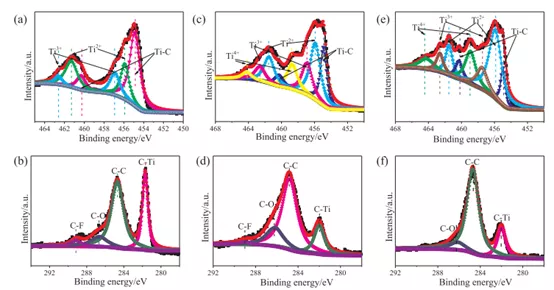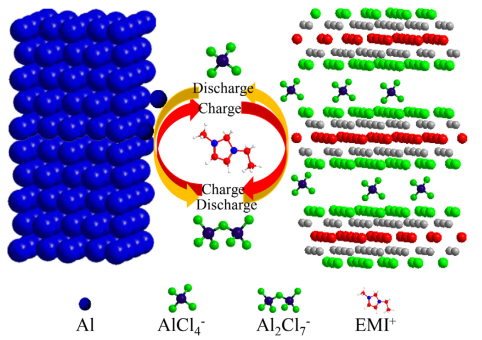
hotline:
17715390137
Tel/Wechat:
18101240246 (Technology)
0512-68565571
Email:mxenes@163.com (Sales Engineer)bkxc.bonnie@gmail.com
Scan the code to follow or search the official account on WeChat:
2D Materials Fronrier After paying attention,
click on the lower right corner to contact us,
Enter enterprise WeChat.
Professional Services Online

已传文件:photo/20206994558444.png
【Research Background】
In recent years, energy storage systems such as lithium ion batteries, metal-air batteries, sodium ion batteries, and aluminum ion batteries (AIBs) have met the huge demand in electric vehicles and other fields. Compared with other metals, aluminum metal is one of the most abundant metal elements in the earth, and its mass capacity can reach 2.98 Ah g-1, which is very close to lithium 3.86 Ah g-1, so secondary aluminum-based batteries are very promising Replace other metal ion batteries. In 2011, using ionic liquid as electrolyte and V2O5 as cathode material achieved a specific capacity of 270 mAh g-1 and a stable cycle performance of 20 cycles. In 2015, an aluminum-graphene battery was reported for the first time, with outstanding electrochemical performance and cycle performance, representing a new breakthrough in the field of AIBs. In the past few years, AIBs have received a lot of attention and research. Although transition metal sulfides and oxides have higher initial discharge capacity, their cycle performance is generally poor, and the energy storage mechanism is not yet clear. . Since 2011, MXene, a two-dimensional sheet-like new transition metal carbon/nitride similar to graphene, has some unique characteristics and is widely used in electrochemical energy storage, electrocatalysis, and water purification. . Among them, Ti-based MXene (Ti3C2) has been deeply and extensively studied in the fields of lithium ion batteries, capacitors and sodium ion batteries.
【Achievement Introduction】
Recently, Professor Zhang Wenming and Professor Zhanyu Li of Hebei University published in the internationally renowned academic journal Chemical Engineering Journal the title: Two-Dimensional Ti3C2@CTAB-Se(MXene) Composite Cathode Material for High-performance Rechargeable Aluminum Batteries. The thesis reported a Ti3C2@CTAB-Se composite successfully prepared by HF etching, CTAB intercalation and Se treatment. Through electrochemical and XPS analysis, it can be concluded that Ti2+/Ti4+ and Se0/Sex+ undergo a reversible redox reaction during the charging and discharging process. In addition, through DFT calculations, the researchers found that Ti3C2O2 has higher conductivity and surface adsorption and diffusion of AlCl4- after selenization.
【Graphic introduction】

Figure 1. Schematic diagram of Ti3C2@CTAB-Se sample synthesis.

Figure 2. SEM images of Ti3C2@CTAB-Se and corresponding samples and element mapping distribution.

Figure 3. HRTEM images of Ti3C2@CTAB-Se and corresponding samples.

Figure 4. The XPS pattern of Ti3C2@CTAB-Se

Figure 5. Electrochemical performance test of Ti3C2@CTAB-Se.

Figure 6. Electrochemical performance test of Ti3C2@CTAB-Se.

Figure 7. The XPS pattern of Ti3C2@CTAB-Se.

Figure 8. Ti3C2@CTAB-Se electrochemical performance test and kinetic analysis.

Figure 9. DFT calculation results.

Figure 10. Ti3C2 charging and discharging process diagram

Figure 11. Comparison of the capacity and voltage of an aluminum ion battery.
【Summary of this article】
The two-dimensional layered Ti3C2@CTAB-Se composite prepared in this paper shows a high specific capacity of 583.7 mAh g-1 at a current density of 100 mA g-1 when applied to an aluminum ion battery. The discharge voltage is about It can reach 1.8 V, and the capacity can remain 132.6mAh g-1 after 400 cycles. Theoretical calculations also prove that Ti3C2O2 has higher conductivity and surface adsorption and diffusion of AlClO4- after selenization. In addition, Ti3C2@CTAB-Se has absolute advantages over oxides, sulfides, and other aluminum-based battery cathode materials in terms of voltage and capacity, and it also has greater advantages compared to V2CTx MXene. In the future, researchers should explore the energy storage mechanism of other MXenes materials as the anode material of aluminum ion batteries, which needs further exploration.
Literature link:
https://doi.org/10.1016/j.cej.2020.125679
Source: MXene Frontie
This information originates from the Internet for academic exchange only. If there is any infringement, please contact us to delete it immediately

| Reminder: Beijing Beike New Material Technology Co., Ltd. supplies products only for scientific research, not for humans |
| All rights reserved © 2019 beijing beike new material Technology Co., Ltd 京ICP备16054715-2号 |